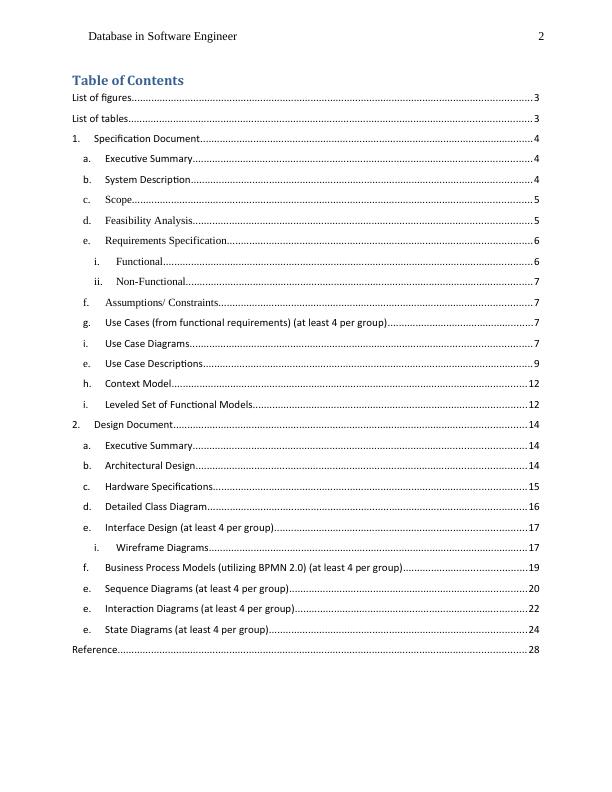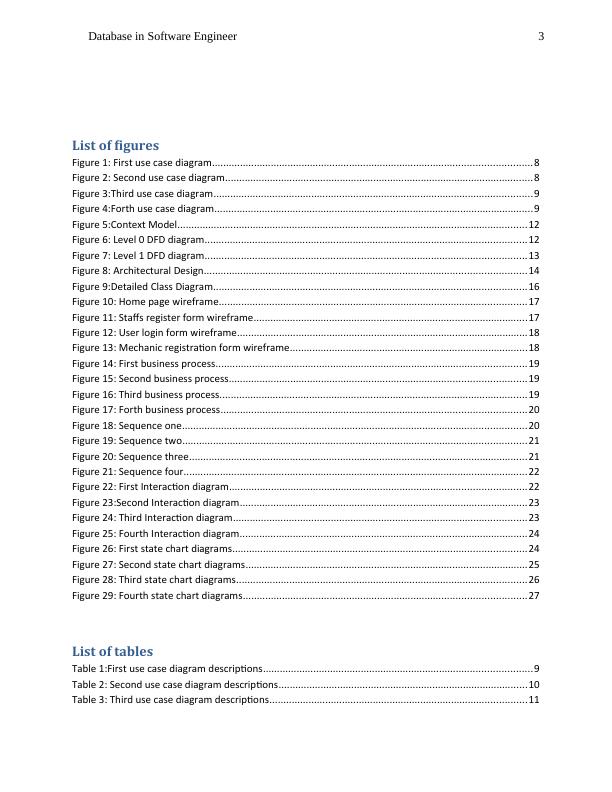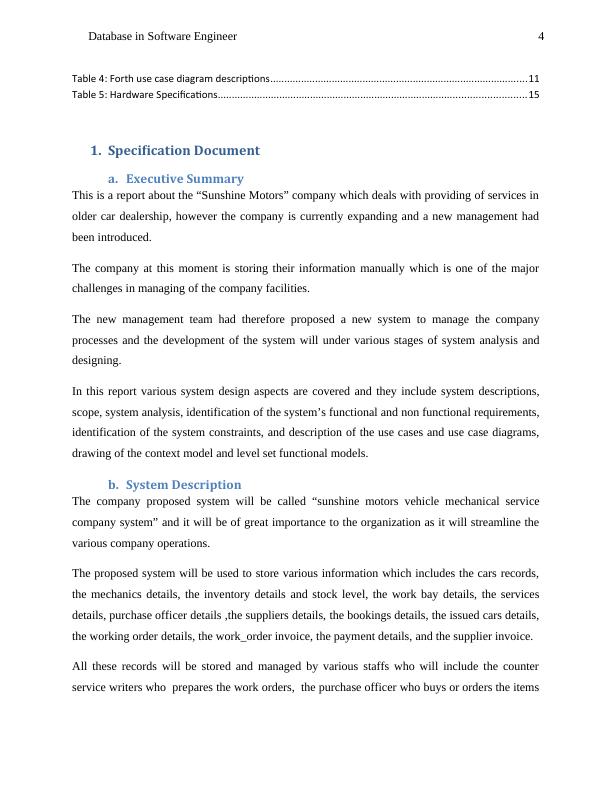Database in Software Engineer
Developing a system for Sunshine Motors' service department to record client information, vehicle details, service history, and mechanics' records.
27 Pages3556 Words21 Views
Added on 2023-01-20
About This Document
This report covers the specification and design aspects of a database system for a car dealership company. It includes executive summary, system description, scope, feasibility analysis, requirements specification, assumptions/constraints, use cases, and design documents.
Database in Software Engineer
Developing a system for Sunshine Motors' service department to record client information, vehicle details, service history, and mechanics' records.
Added on 2023-01-20
ShareRelated Documents
1Database in Software Engineer
DATABASE IN SOFTWARE ENGINEER
[Student name]
[University name]
[Professor Name]
[Date]
DATABASE IN SOFTWARE ENGINEER
[Student name]
[University name]
[Professor Name]
[Date]

2Database in Software Engineer
Table of Contents
List of figures...............................................................................................................................................3
List of tables................................................................................................................................................3
1. Specification Document.......................................................................................................................4
a. Executive Summary.........................................................................................................................4
b. System Description..........................................................................................................................4
c. Scope...............................................................................................................................................5
d. Feasibility Analysis.........................................................................................................................5
e. Requirements Specification.............................................................................................................6
i. Functional....................................................................................................................................6
ii. Non-Functional............................................................................................................................7
f. Assumptions/ Constraints................................................................................................................7
g. Use Cases (from functional requirements) (at least 4 per group)....................................................7
i. Use Case Diagrams..........................................................................................................................7
e. Use Case Descriptions......................................................................................................................9
h. Context Model...............................................................................................................................12
i. Leveled Set of Functional Models..................................................................................................12
2. Design Document..............................................................................................................................14
a. Executive Summary.......................................................................................................................14
b. Architectural Design......................................................................................................................14
c. Hardware Specifications................................................................................................................15
d. Detailed Class Diagram..................................................................................................................16
e. Interface Design (at least 4 per group)..........................................................................................17
i. Wireframe Diagrams..................................................................................................................17
f. Business Process Models (utilizing BPMN 2.0) (at least 4 per group)............................................19
e. Sequence Diagrams (at least 4 per group).....................................................................................20
e. Interaction Diagrams (at least 4 per group)...................................................................................22
e. State Diagrams (at least 4 per group)............................................................................................24
Reference..................................................................................................................................................28
Table of Contents
List of figures...............................................................................................................................................3
List of tables................................................................................................................................................3
1. Specification Document.......................................................................................................................4
a. Executive Summary.........................................................................................................................4
b. System Description..........................................................................................................................4
c. Scope...............................................................................................................................................5
d. Feasibility Analysis.........................................................................................................................5
e. Requirements Specification.............................................................................................................6
i. Functional....................................................................................................................................6
ii. Non-Functional............................................................................................................................7
f. Assumptions/ Constraints................................................................................................................7
g. Use Cases (from functional requirements) (at least 4 per group)....................................................7
i. Use Case Diagrams..........................................................................................................................7
e. Use Case Descriptions......................................................................................................................9
h. Context Model...............................................................................................................................12
i. Leveled Set of Functional Models..................................................................................................12
2. Design Document..............................................................................................................................14
a. Executive Summary.......................................................................................................................14
b. Architectural Design......................................................................................................................14
c. Hardware Specifications................................................................................................................15
d. Detailed Class Diagram..................................................................................................................16
e. Interface Design (at least 4 per group)..........................................................................................17
i. Wireframe Diagrams..................................................................................................................17
f. Business Process Models (utilizing BPMN 2.0) (at least 4 per group)............................................19
e. Sequence Diagrams (at least 4 per group).....................................................................................20
e. Interaction Diagrams (at least 4 per group)...................................................................................22
e. State Diagrams (at least 4 per group)............................................................................................24
Reference..................................................................................................................................................28

3Database in Software Engineer
List of figures
Figure 1: First use case diagram..................................................................................................................8
Figure 2: Second use case diagram..............................................................................................................8
Figure 3:Third use case diagram..................................................................................................................9
Figure 4:Forth use case diagram..................................................................................................................9
Figure 5:Context Model.............................................................................................................................12
Figure 6: Level 0 DFD diagram...................................................................................................................12
Figure 7: Level 1 DFD diagram...................................................................................................................13
Figure 8: Architectural Design...................................................................................................................14
Figure 9:Detailed Class Diagram................................................................................................................16
Figure 10: Home page wireframe..............................................................................................................17
Figure 11: Staffs register form wireframe..................................................................................................17
Figure 12: User login form wireframe........................................................................................................18
Figure 13: Mechanic registration form wireframe.....................................................................................18
Figure 14: First business process...............................................................................................................19
Figure 15: Second business process..........................................................................................................19
Figure 16: Third business process..............................................................................................................19
Figure 17: Forth business process.............................................................................................................20
Figure 18: Sequence one...........................................................................................................................20
Figure 19: Sequence two...........................................................................................................................21
Figure 20: Sequence three.........................................................................................................................21
Figure 21: Sequence four...........................................................................................................................22
Figure 22: First Interaction diagram..........................................................................................................22
Figure 23:Second Interaction diagram.......................................................................................................23
Figure 24: Third Interaction diagram.........................................................................................................23
Figure 25: Fourth Interaction diagram.......................................................................................................24
Figure 26: First state chart diagrams.........................................................................................................24
Figure 27: Second state chart diagrams.....................................................................................................25
Figure 28: Third state chart diagrams........................................................................................................26
Figure 29: Fourth state chart diagrams.....................................................................................................27
List of tables
Table 1:First use case diagram descriptions................................................................................................9
Table 2: Second use case diagram descriptions.........................................................................................10
Table 3: Third use case diagram descriptions............................................................................................11
List of figures
Figure 1: First use case diagram..................................................................................................................8
Figure 2: Second use case diagram..............................................................................................................8
Figure 3:Third use case diagram..................................................................................................................9
Figure 4:Forth use case diagram..................................................................................................................9
Figure 5:Context Model.............................................................................................................................12
Figure 6: Level 0 DFD diagram...................................................................................................................12
Figure 7: Level 1 DFD diagram...................................................................................................................13
Figure 8: Architectural Design...................................................................................................................14
Figure 9:Detailed Class Diagram................................................................................................................16
Figure 10: Home page wireframe..............................................................................................................17
Figure 11: Staffs register form wireframe..................................................................................................17
Figure 12: User login form wireframe........................................................................................................18
Figure 13: Mechanic registration form wireframe.....................................................................................18
Figure 14: First business process...............................................................................................................19
Figure 15: Second business process..........................................................................................................19
Figure 16: Third business process..............................................................................................................19
Figure 17: Forth business process.............................................................................................................20
Figure 18: Sequence one...........................................................................................................................20
Figure 19: Sequence two...........................................................................................................................21
Figure 20: Sequence three.........................................................................................................................21
Figure 21: Sequence four...........................................................................................................................22
Figure 22: First Interaction diagram..........................................................................................................22
Figure 23:Second Interaction diagram.......................................................................................................23
Figure 24: Third Interaction diagram.........................................................................................................23
Figure 25: Fourth Interaction diagram.......................................................................................................24
Figure 26: First state chart diagrams.........................................................................................................24
Figure 27: Second state chart diagrams.....................................................................................................25
Figure 28: Third state chart diagrams........................................................................................................26
Figure 29: Fourth state chart diagrams.....................................................................................................27
List of tables
Table 1:First use case diagram descriptions................................................................................................9
Table 2: Second use case diagram descriptions.........................................................................................10
Table 3: Third use case diagram descriptions............................................................................................11

4Database in Software Engineer
Table 4: Forth use case diagram descriptions............................................................................................11
Table 5: Hardware Specifications..............................................................................................................15
1. Specification Document
a. Executive Summary
This is a report about the “Sunshine Motors” company which deals with providing of services in
older car dealership, however the company is currently expanding and a new management had
been introduced.
The company at this moment is storing their information manually which is one of the major
challenges in managing of the company facilities.
The new management team had therefore proposed a new system to manage the company
processes and the development of the system will under various stages of system analysis and
designing.
In this report various system design aspects are covered and they include system descriptions,
scope, system analysis, identification of the system’s functional and non functional requirements,
identification of the system constraints, and description of the use cases and use case diagrams,
drawing of the context model and level set functional models.
b. System Description
The company proposed system will be called “sunshine motors vehicle mechanical service
company system” and it will be of great importance to the organization as it will streamline the
various company operations.
The proposed system will be used to store various information which includes the cars records,
the mechanics details, the inventory details and stock level, the work bay details, the services
details, purchase officer details ,the suppliers details, the bookings details, the issued cars details,
the working order details, the work_order invoice, the payment details, and the supplier invoice.
All these records will be stored and managed by various staffs who will include the counter
service writers who prepares the work orders, the purchase officer who buys or orders the items
Table 4: Forth use case diagram descriptions............................................................................................11
Table 5: Hardware Specifications..............................................................................................................15
1. Specification Document
a. Executive Summary
This is a report about the “Sunshine Motors” company which deals with providing of services in
older car dealership, however the company is currently expanding and a new management had
been introduced.
The company at this moment is storing their information manually which is one of the major
challenges in managing of the company facilities.
The new management team had therefore proposed a new system to manage the company
processes and the development of the system will under various stages of system analysis and
designing.
In this report various system design aspects are covered and they include system descriptions,
scope, system analysis, identification of the system’s functional and non functional requirements,
identification of the system constraints, and description of the use cases and use case diagrams,
drawing of the context model and level set functional models.
b. System Description
The company proposed system will be called “sunshine motors vehicle mechanical service
company system” and it will be of great importance to the organization as it will streamline the
various company operations.
The proposed system will be used to store various information which includes the cars records,
the mechanics details, the inventory details and stock level, the work bay details, the services
details, purchase officer details ,the suppliers details, the bookings details, the issued cars details,
the working order details, the work_order invoice, the payment details, and the supplier invoice.
All these records will be stored and managed by various staffs who will include the counter
service writers who prepares the work orders, the purchase officer who buys or orders the items

5Database in Software Engineer
from the suppliers, the service manager who manages the order services and the mechanics who
decrements the inventory after any service.
c. Scope
The proposed system will be used to perform various functions and below is the scope which
will be covered by the system.
i. Recording the mechanics details.
ii. Recording the mechanics roasters.
iii. Recording the items/consumable inventory.
iv. Recording the work bay records.
v. Recording the issued cars and the client’s details.
vi. Recording the bookings, available date and the client’s record.
vii. Recording the work orders and the respective customer details and the service
finishing date.
viii. Recording the allocated mechanics to the respective work orders, and the
items/consumables used.
ix. Recording the work order invoices stating the amount to be paid and payment status.
x. Recording the work order payments and sending notifications to the customers while
the order is completed.
xi. Recording the suppliers details and the products they supplies.
xii. Recording the supplier invoices for supplies payment.
d. Feasibility Analysis
The current system in the company is having various challenges due to lack of information
system , computerized system , lack of database system , poor record keeping and retrieval , high
risk of data loss and uncontrolled information security.
The implementation of the proposed system will be accompanied by various advantages to the
organization as justified below.
i. The system will prevent data and information loss.
ii. The system will ease the record keeping and retrieval.
iii. The system will improve the information security.
from the suppliers, the service manager who manages the order services and the mechanics who
decrements the inventory after any service.
c. Scope
The proposed system will be used to perform various functions and below is the scope which
will be covered by the system.
i. Recording the mechanics details.
ii. Recording the mechanics roasters.
iii. Recording the items/consumable inventory.
iv. Recording the work bay records.
v. Recording the issued cars and the client’s details.
vi. Recording the bookings, available date and the client’s record.
vii. Recording the work orders and the respective customer details and the service
finishing date.
viii. Recording the allocated mechanics to the respective work orders, and the
items/consumables used.
ix. Recording the work order invoices stating the amount to be paid and payment status.
x. Recording the work order payments and sending notifications to the customers while
the order is completed.
xi. Recording the suppliers details and the products they supplies.
xii. Recording the supplier invoices for supplies payment.
d. Feasibility Analysis
The current system in the company is having various challenges due to lack of information
system , computerized system , lack of database system , poor record keeping and retrieval , high
risk of data loss and uncontrolled information security.
The implementation of the proposed system will be accompanied by various advantages to the
organization as justified below.
i. The system will prevent data and information loss.
ii. The system will ease the record keeping and retrieval.
iii. The system will improve the information security.

6Database in Software Engineer
iv. The system will improve the communication level as there will be notifications.
v. The system will improve on the financial security as the customers can pay through
visa, or paypal system.
vi. The system will enable easy inventory revel updating, tracking and management.
vii. The system will make it easy for the purchase officer to order new stock from the
suppliers and update new stock.
viii. The system will enable easy generation of supplier invoice and making payment.
e. Requirements Specification
i. Functional
Below are the proposed system functional requirements.
a. The system should enable user’s registration.
b. The system should enable user’s login.
c. The system should be able to record the mechanics details.
d. The system should be able to record the mechanics roasters.
e. The system should be able to record the items/consumable inventory.
f. The system should be able to record the work bay records.
g. The system should be able to record the issued cars and the client’s details.
h. The system should be able to record the bookings, available date and the client’s record.
i. The system should be able to record the work orders and the respective customer details
and the service finishing date.
j. The system should be able to record the allocated mechanics to the respective work
orders, and the items/consumables used.
k. The system should be able to record the work order invoices stating the amount to be paid
and payment status.
l. The system should be able to record the work order payments and sending notifications to
the customers while the order is completed.
m. The system should be able to record the supplier’s details and the products they supplies.
n. The system should be able to record the supplier invoices for supplies payment.
iv. The system will improve the communication level as there will be notifications.
v. The system will improve on the financial security as the customers can pay through
visa, or paypal system.
vi. The system will enable easy inventory revel updating, tracking and management.
vii. The system will make it easy for the purchase officer to order new stock from the
suppliers and update new stock.
viii. The system will enable easy generation of supplier invoice and making payment.
e. Requirements Specification
i. Functional
Below are the proposed system functional requirements.
a. The system should enable user’s registration.
b. The system should enable user’s login.
c. The system should be able to record the mechanics details.
d. The system should be able to record the mechanics roasters.
e. The system should be able to record the items/consumable inventory.
f. The system should be able to record the work bay records.
g. The system should be able to record the issued cars and the client’s details.
h. The system should be able to record the bookings, available date and the client’s record.
i. The system should be able to record the work orders and the respective customer details
and the service finishing date.
j. The system should be able to record the allocated mechanics to the respective work
orders, and the items/consumables used.
k. The system should be able to record the work order invoices stating the amount to be paid
and payment status.
l. The system should be able to record the work order payments and sending notifications to
the customers while the order is completed.
m. The system should be able to record the supplier’s details and the products they supplies.
n. The system should be able to record the supplier invoices for supplies payment.

End of preview
Want to access all the pages? Upload your documents or become a member.
Related Documents
Unit 9: Software Development Life Cyclelg...
|46
|9041
|1314
System and Design Document for Online Library Management Systemlg...
|21
|2836
|213
Order and Components - Thesis and Dissertation Guidelg...
|8
|967
|75
Software Engineering Methodology: Design, Architecture, and Hardware Specificationslg...
|17
|974
|418
Contemporary Software Developmentlg...
|30
|4800
|255
Design Document Name of the Student Name of the University Author's Note SOFTWARE ENGINEERING METHODOLOGY Software Engineering Methodologylg...
|11
|525
|427
